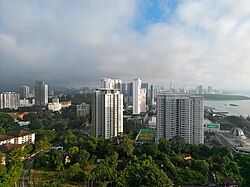
Back Gelugor Esperanto گلوگور Persian Gelugor French Gelugor Malay Gelugor Dutch Gelugor Polish குளுகோர் Tamil Gelugor Vietnamese 牛汝莪 Chinese
Gelugor | |
|---|---|
Suburb of George Town | |
| Other transcription(s) | |
| • Mandarin | 牛汝莪 Niú rǔ'é (Pinyin) |
| • Hokkien | Gû-lú-gô (Tâi-lô) |
| • Tamil | குளுகோர் |
 | |
 | |
| Coordinates: 5°22′7.91″N 100°18′22.29″E / 5.3688639°N 100.3061917°E | |
| Country | |
| State | |
| City | |
| District | Northeast |
| Area | |
• Total | 2.9 km2 (1.1 sq mi) |
| Population (2020)[1] | |
• Total | 18,662 |
| • Density | 6,400/km2 (17,000/sq mi) |
| Demographics | |
| • Ethnic groups | |
| Time zone | UTC+8 (MST) |
| • Summer (DST) | Not observed |
| Postal code | 11700 |
Gelugor[a] is a suburb of George Town in the Malaysian state of Penang. Named after a plant species, Gelugor lies along the eastern seaboard of Penang Island, between Jelutong and Sungai Dua, and nearly 5 km (3.1 mi) south of the city centre.
Gelugor had been populated as early as the late 18th century by Malay fishermen who arrived from Sumatra.[2] The area was then cleared for agricultural plantations by David Brown, a partner of Captain Francis Light.
Urbanisation of the area began in earnest in the 1960s, when residential estates were established within the area. Gelugor gradually turned into a suburb, helped by its strategic location right in between the city centre and Bayan Lepas to the south. In 1969, Universiti Sains Malaysia was founded at Gelugor and is now one of the top Malaysian public universities.
- ^ a b "MyCensus 2020: Mukim/Town/Pekan". Department of Statistics Malaysia. Putrajaya: 174–175. February 2024. ISBN 9789672537069.
- ^ "Batu Uban: The earliest Malay settlement in Penang - Malaysia Premier Property and Real Estate Portal". Malaysia Premier Property and Real Estate Portal. Retrieved 16 May 2017.
Cite error: There are <ref group=lower-alpha> tags or {{efn}} templates on this page, but the references will not show without a {{reflist|group=lower-alpha}} template or {{notelist}} template (see the help page).
